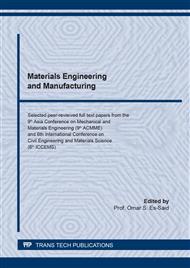[1]
Shen, S. Recent advances on the fundamental research of spatial structures in China. Journal of the International Association for Shell and Spatial Structures, 2006. 47(1): pp.93-100.
Google Scholar
[2]
Dong, P., A structural stress definition and numerical implementation for fatigue analysis of welded joints. International Journal of Fatigue, 2001. 23(10): pp.865-876.
DOI: 10.1016/s0142-1123(01)00055-x
Google Scholar
[3]
Dong, P., Z. Wei and J.K. Hong, A path-dependent cycle counting method for variable-amplitude multi-axial loading. International Journal of Fatigue, 2010. 32(4): pp.720-734.
DOI: 10.1016/j.ijfatigue.2009.10.010
Google Scholar
[4]
Jorge A.R.D. and J.R.D.C. Dionisio, An evaluation of the nominal stress method for life prediction of cylindrical circumferential V-notched specimens tested under variable amplitude loading. 2016: Incheon,Korea. p.1.
DOI: 10.4028/www.scientific.net/amm.851.310
Google Scholar
[5]
Susmel, L. and R. Tovo, On the use of nominal stresses to predict the fatigue strength of welded joints under biaxial cyclic loading. Fatigue & Fracture of Engineering Materials & Structures, 2010. 27(11): pp.1005-1024.
DOI: 10.1111/j.1460-2695.2004.00814.x
Google Scholar
[6]
Aygul, M., M. Al-Emrani and S. Urushadze, Modelling and fatigue life assessment of orthotropic bridge deck details using FEM. International Journal of Fatigue, 2012. 40: pp.129-142.
DOI: 10.1016/j.ijfatigue.2011.12.015
Google Scholar
[7]
Kim, M. and S. Kang, Testing and analysis of fatigue behaviour in edge details: a comparative study using hot spot and structural stresses. Kyobu Geka the Japanese Journal of Thoracic Surgery, 2008. 61(4): pp.331-4.
Google Scholar
[8]
Hyuba, H and Dong,P. Equilibrium-Equivalent Structural Stress Approach to Fatigue Evaluation of a Rectangular Hollow Section Joint. International Journal of Fatigue, 2005. 27(1): pp.85-100.
DOI: 10.1016/j.ijfatigue.2004.05.008
Google Scholar
[9]
Gates, N. and A. Fatemi, Fatigue crack growth behavior in the presence of notches and multiaxial nominal stress states. Engineering Fracture Mechanics, 2016. 165: pp.24-38.
DOI: 10.1016/j.engfracmech.2016.08.017
Google Scholar
[10]
Kang, H., P. Dong and J. Hong, Fatigue analysis of spot welds using a mesh-insensitive structural stress approach. International Journal of Fatigue, 2007. 29(8): pp.1546-1553.
DOI: 10.1016/j.ijfatigue.2006.10.025
Google Scholar
[11]
Xiao, Z.G., et al., Fatigue cracks in longitudinal ribs of steel orthotropic deck. International Journal of Fatigue, 2006. 28(4): pp.409-416.
DOI: 10.1016/j.ijfatigue.2005.07.017
Google Scholar
[12]
Xiao, Z.G., et al., Stress analyses and fatigue evaluation of rib-to-deck joints in steel orthotropic decks. International Journal of Fatigue, 2008. 30(8): pp.1387-1397.
DOI: 10.1016/j.ijfatigue.2007.10.008
Google Scholar
[13]
BuAr T , Nagode M , Fajdiga M . A neural network approach to describing the scatter of S–N curves. International Journal of Fatigue, 2006. 28(4): pp.311-323.
DOI: 10.1016/j.ijfatigue.2005.08.002
Google Scholar
[14]
Yang HB, et al. Fatigue behavior of typical details of orthotropic steel bridges in multiaxial stress states using traction structural stress [J]. International Journal of Fatigue, 2020. 141(12): pp.1-16.
DOI: 10.1016/j.ijfatigue.2020.105862
Google Scholar
[15]
Yang HB, et al. Fatigue property analysis of U rib-to-crossbeam connections under heavy traffic vehicle load considering in-plane shear stress [J]. Steel and composite structures, 2021. 38(3): pp.271-280.
Google Scholar
[16]
Yang HB, et al. Fatigue property of U rib-crossbeam-deck connections in OBD under combined loading of bending and torsion [J]. Theoretical and applied fracture mechanics, 2021. 112(1): pp.1-20.
DOI: 10.1016/j.tafmec.2020.102889
Google Scholar
[17]
Yang HB, et al. Fatigue Performance of Different Rib-To-Deck Connections Using Traction Structural Stress Method [J]. Applied Sciences, 2020. 4(1): pp.1-16.
DOI: 10.3390/app10041239
Google Scholar
[18]
Haibo Yang. Performance analysis of semi-rigid connections in prefabricated high-rise steel structures [J]. Structures, 2020. 12(12): pp.1-20.
DOI: 10.1016/j.istruc.2020.09.036
Google Scholar
[19]
Yang HB, et al. Analysis of fatigue behavior of welded joints in orthotropic bridge deck using traction structural stress [J]. Advances in Mechanical Engineering, 2019. 11(11): pp.14-30.
DOI: 10.1177/1687814019890217
Google Scholar
[20]
Wang P, et al. Traction structural stress analysis of fatigue behaviors of rib-to-deck joints in orthotropic bridge deck. International Journal of Fatigue, 2019. 125(1): pp.11-22.
DOI: 10.1016/j.ijfatigue.2019.03.038
Google Scholar


